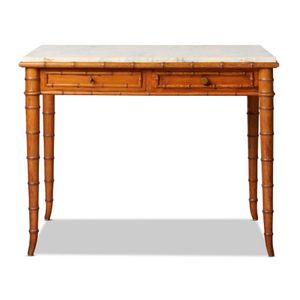Marble-top Side Table by H. Lemoine, Paris
A French marble-topped oak and pine side table, H. Lemoine, Paris, early 20th century, the rectangular top with inset grey-veined pink marble above a pair of frieze drawers, raised on tapering turned supports, the mouldings and supports turned to simulate bamboo, Lemoine's stamp to the top beneath the marble, 75 cm high, 95 cm wide, 60 cm deep,
You must be a subscriber, and be logged in to view price and dealer details.
Subscribe Now to view actual auction price for this item
When you subscribe, you have the option of setting the currency in which to display prices to $Au, $US, $NZ or Stg.
This item has been sold, and the description, image and price are for reference purposes only.
- Oak - Native to Europe and England, oak has been used for joinery, furniture and building since the beginning of the medieval civilisation. It is a pale yellow in colour when freshly cut and darkens with age to a mid brown colour.
Oak as a furniture timber was superceded by walnut in the 17th century, and in the 18th century by mahogany,
Semi-fossilised bog oak is black in colour, and is found in peat bogs where the trees have fallen and been preserved from decay by the bog. It is used for jewellery and small carved trinkets.
Pollard oak is taken from an oak that has been regularly pollarded, that is the upper branches have been removed at the top of the trunk, result that new branches would appear, and over time the top would become ball-like. . When harvested and sawn, the timber displays a continuous surface of knotty circles. The timber was scarce and expensive and was used in more expensive pieces of furniture in the Regency and Victorian periods. - Mouldings - Decorative strips, deriving from architectural features, that may be either applied separately to a piece of furniture or worked directly on to the carcase. Mouldings are found on cornices or pediments, around the edges of panels and drawer fronts, and around both the tops and bottoms of chests, bookcases and other cabinet furniture. Until the late 19th century mouldings were worked by hand, using a shaped moulding plane. Latterly, they have been shaped by machine.
- Frieze - An architectural term denoting the flat, shaped or convex horizontal surface of furniture, between the architrave and the cornice, usually found on a cabinet or bookcase, or on desks and tables where it may include drawers, the area between the top and the legs. In ceramics, the term refers to the banding, of usually a repeating pattern, on the rims of plates and vases.
- Turning - Any part of a piece of furniture that has been turned and shaped with chisels on a lathe. Turned sections include legs, columns, feet, finials, pedestals, stretchers, spindles etc. There have been many varieties and fashions over the centuries: baluster, melon, barley-sugar, bobbin, cotton-reel, rope-twist, and so on. Split turning implies a turned section that has been cut in half lengthwise and applied to a cabinet front as a false decorative support.
This item has been included into following indexes:
